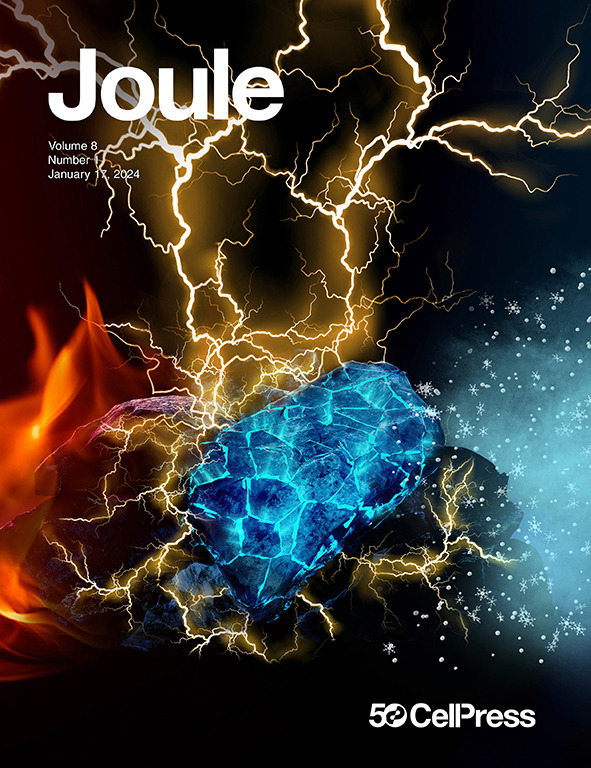一种用于水相有机氧化还原液流电池的集成微相分离和固有微孔聚合物膜
IF 35.4
1区 材料科学
Q1 CHEMISTRY, PHYSICAL
引用次数: 0
摘要
水相有机氧化还原液流电池(AORFB)是一种很有前途的大规模、长时间储能电化学技术,它需要高导电性和选择性的离子交换膜。传统的多孔和微相分离膜经常在高离子电导率和低活性物质交叉之间进行权衡,这仍然是一个持续的研究挑战。在这里,我们提出了一个关键的设计策略,将尺寸限制的微相分离和固有的微孔隙度集成在可溶液处理Tröger的基础(TB)框架中。通过在顺序合成中引入延迟实现的三臂分支连接剂和半刚性聚合物骨架,所得到的支链结核膜b-DPM-N3具有高导电性和选择性(各种活性材料的渗透率低至10 - 12 cm2/s),并展示了其在AORFBs中的效率,具有创纪录的功率密度,在300 mA/cm2电流密度下高达42%的能量效率。这种设计理念为电化学装置中的膜应用提供了广阔的潜力。本文章由计算机程序翻译,如有差异,请以英文原文为准。


A polymer membrane with integrated microphase separation and intrinsic microporosity for aqueous organic redox flow batteries
The aqueous organic redox flow battery (AORFB) is a promising electrochemical technology for large-scale and long-duration energy storage, requiring highly conductive and selective ion-exchange membranes. Traditional porous and microphase-separated membranes often present a tradeoff between high ion conductivity and low crossover of active species, remaining a persistent research challenge. Here, we propose a key design strategy that integrates size-confined microphase separation and intrinsic microporosity within a solution-processable Tröger’s base (TB) framework. By introducing a delayed implementation of a three-armed branch linker and a semi-rigid polymer backbone in a sequential synthesis, the resulting branched TB membrane b-DPM-N3, demonstrates both high conductivity and selectivity (as low as 10−12 cm2/s permeability of various active materials) and showcases its efficiency in AORFBs with record power density and up to 42% energy efficiency under 300 mA/cm2 current density. This design concept offers broad potential for membrane applications in electrochemical devices.
求助全文
通过发布文献求助,成功后即可免费获取论文全文。
去求助
来源期刊

Joule
Energy-General Energy
CiteScore
53.10
自引率
2.00%
发文量
198
期刊介绍:
Joule is a sister journal to Cell that focuses on research, analysis, and ideas related to sustainable energy. It aims to address the global challenge of the need for more sustainable energy solutions. Joule is a forward-looking journal that bridges disciplines and scales of energy research. It connects researchers and analysts working on scientific, technical, economic, policy, and social challenges related to sustainable energy. The journal covers a wide range of energy research, from fundamental laboratory studies on energy conversion and storage to global-level analysis. Joule aims to highlight and amplify the implications, challenges, and opportunities of novel energy research for different groups in the field.
 求助内容:
求助内容: 应助结果提醒方式:
应助结果提醒方式:


